Development of High-Efficiency Continuous Casting Technologies
[Aiming for world-leading technologies through use of proprietary technologies and collaboration with universities]
2008.10.16
- Sumitomo Metal Industries, Ltd.
Sumitomo Metal Industries, Ltd. (Sumitomo Metals) Corporate Research & Development Laboratories has developed technologies that utilize the Company's proprietary technologies and the results of collaboration with universities. Sumitomo Metals has developed a continuous casting technology that inhibits the clogging of submerged immersion nozzles(*1), a technology that controls solidification within molds, and a technology that prevents meniscus level fluctuation in the mold. These technologies will improve product quality and manufacturing productivity.
1. Background to development
The continuous casting is a process that entails supplying molten steel in a ladle to a mold via an intermediate vessel called a tundish to solidify.
There are two methods of increasing productivity in continuous casting process. One is to increase the number of sequential castings(*2), thereby raising the casting-time ratio. The other is to increase the casting velocity. As we increase the number of sequential castings to raise productivity, we face the poblem of nozzle clogging due to the accumulation of alumina and other substances on the inner surface of the submerged entry nozzle (SEN). As we increase casting velocity, we tend to have the defects called longitudinal cracks in slabs and meniscus level fluctuation of molten steel surface in the mold, caused by unsteady bulging(*3), thereby causing the negative impact on the quality and productivity (see Figure 1).
To tackle these problems, Sumitomo Metals has developed three technologies: a technology to prevent nozzle clogging (AI nozzle(*4)) that employs an electro-chemical action, mold flux for high-speed casting that prevents uneven solidification (Cry-Max(*5)), and a technology to control the meniscus level in the mold that focuses on the frequency distribution of fluctuation in the meniscus (Q-H infinity control(*6)).
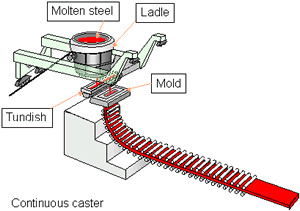
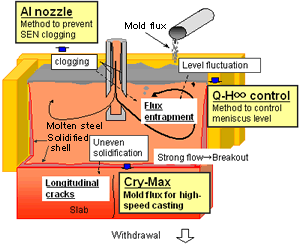
Figure 1. Continuous caster and relation between behavior in mold and slab quality
2. Overview of new technologies
(1) Nozzle clogging prevention method (AI nozzle)
Alumina and other substances accumulate on the inner surface of the SEN of continuous caster. Conventional countermeasures are argon gas injection and improvement of the material or design of the SEN. These conventional techniques were not as effective as we expected to prevent nozzle clogging.
Sumitomo Metals discovered through experiment that an electric current applied from nozzle to molten steel substantially reduce the adhesion of alumina on the surface of nozzle. Tests on the actual casters confirmed this observation (see Figures 2, 3) that there was a clogging prevention effect. This technology is epoch making because its concept is entirely different from conventional ways but without the harmful side effects.
Sumitomo Metals is endeavoring to clarify the detailed mechanism of this technology and to optimize its application in collaboration with Osaka University.
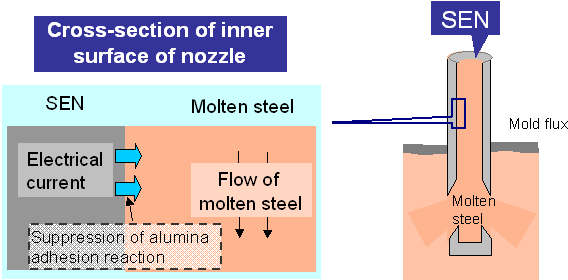
Figure 2. Prevention of nozzle clogging
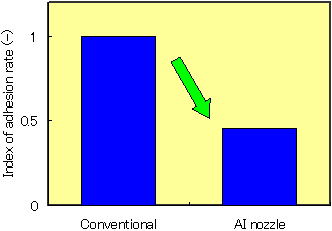
Figure 3. Adhesion prevention effect in continuous caster
(2) Mold flux for continuous casting (Cry-Max)
When casting high-strength steel, the solidified shell thickness in the mold tends to become uneven (uneven solidification), so we had to slowe down casting velocity to prevent defects like longitudinal cracks, thereby lowering productivity.
The purpose of applying mold flux is providing lubrication between the mold and the solidified shell and preserving the temperature of the molten steel meniscus in the mold. By promoting the crystallization of flux film(*7) to the maximum extent, Sumitomo Metals has developed mold flux based on the new concepts of reinforce the effect of thermal insulation, hindering the rapid cooling of the surface of the solidified shell, and homogenizing the thickness of the solidified shell (see Figure 4).
This new mold flux decrease surface defects (see Figure 5). It also prevents breakout(*8), a major operation trouble for continuous casters.
This technology is a further developed version of the technology that won the National Commendation for Innovation, Innovation Prize (2007). Sumitomo Metals is undertaking research regarding the properties of mold flux and endeavoring to elucidate the phenomenon of the solidification of steel as part of collaboration with universities.
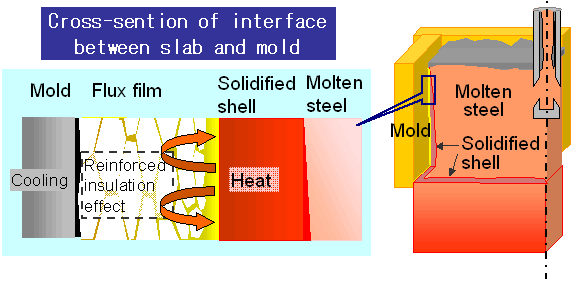
Figure 4. Design concept of mold flux for high-speed casting
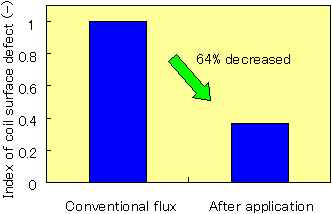
Figure 5. Effect of improvement in defects caused by mold flux
(3) Method of controlling meniscus level in mold (Q-H infinity control)
The molten steel meniscus level in the mold of a continuous caster is detected and controlled by opening and closing slide gates(*9) that control the volume of molten steel supplied in the mold. Higher casting velocity tends to cause perodic and large fluctuation of the meniscus level. This phenomenon, called unsteady bulging(see Figure 6) is caused by slab bulging between rolls. This meniscus fluctuation could cause defects such as the entrapment of the mold flux in the slab.
In response to this problem, Sumitomo Metals developed a method of controlling the meniscus level in the mold by adding the original concept of the phase compensator block(*10). This focuses on the fact that frequency distribution in meniscus fluctuation has specific peaks. By analyzing these frequencies, this method preemptively eliminates the corresponding fluctuation based on calculation. As a result, it was possible to dramatically enhance the performance of control of level fluctuation periodically compared to conventional control methods. With this invented control device, Sumitomo Metals reduced the amplitude in the 0.27Hz cycle, equivalent to the unsteady bulging, to less than one-tenth of the initial level (see Figure 7).
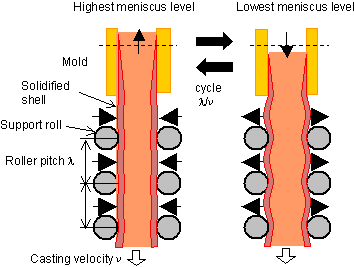
Figure 6.
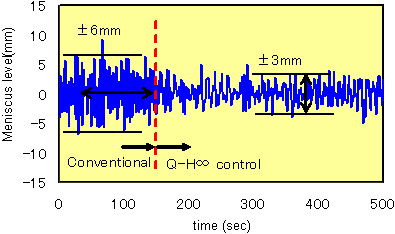
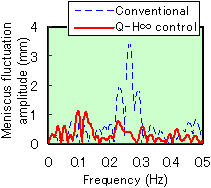
Figure 7. Comparison of effect of application of this control device and conventional
3. Collaboration with universities
Sumitomo Metals is promoting joint research regarding elucidation of fundamental mechanisms and the study of properties in cooperation with various universities such as Osaka University, which has established cooperative courses.
These coutinuous casting technologies have been made possible through the collaboration with universities.
Notes on Technical Terms
(*1) Submerged entry nozzle (SEN): The nozzle that supplies molten steel from the tundish to the mold is called a submerged entry nozzle.
(*2): Number of sequential castings: To enhance efficiency in continuous casting, ladles are replaced during casting, which enables continuous casting operation without halt. The number of ladles that are cast continuously is called the number of sequential castings.
(*3) Bulging: As slabs are supported by rolls after withdrawn from the mold, the solidified shell sometimes expands btween the rolls due to the pressure (static pressure) of the non-solidified molten steel inside of the slab. This phenomenon is called bulging.
(*4) AI nozzle: An abbreviation for Anti-Clogging Immersion. This means a submerged immersion nozzle that prevents clogging.
(*5) Cry-Max: An abbreviation for Crystallization Maximum. This means flux designed to achieve maximum crystallization.
(*6) Q-H infinity control: An abbreviation for Q-parameterized H infinity control. This means control attuned to frequency.
(*7) Flux film: Mold flux distributed on the surface of molten steel in the mold melts due to the heat, flows in between the mold and the solidified shell, and forms a film. This layer is called flux film.
(*8) Breakout: This is an operational accident of continuous caster when a crack in the the solidified shell opens up and the molten steel in the inner part leaks out. It causes a large loss in productivity.
(*9) Slide gates: The rate of molten steel flow supplied from the tundish to the mold is controlled by sliding two refractory plates with a bore. This flow control system is called a slide gate.
(*10) Phase compensator block: This performs arithmetic calculation to pre-emptively adjust the slide gate, so as to stabilize molten steel volume in the mold, by offsetting the fluctuations of specific frequency based on a calculation.
